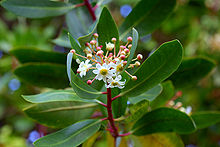| Drimys winteri | |
|---|---|

| |

| |
| Young adult | |
| Scientific classification | |
| Kingdom: | Plantae |
| Clade: | Tracheophytes |
| Clade: | Angiosperms |
| Clade: | Magnoliids |
| Order: | Canellales |
| Family: | Winteraceae |
| Genus: | Drimys |
| Species: | D. winteri
|
| Binomial name | |
| Drimys winteri | |

Drimys winteri, also known as Winter's bark, foye[2] and canelo, is a slender species of tree in the family Winteraceae, growing up to 20 m (66 ft) tall. It is native to the Magellanic and Valdivian temperate forests of Chile and Argentina, where it is a dominant tree in the coastal evergreen forests. It is found below 1,200 m (3,900 ft) between latitude 32° south and Cape Horn at latitude 56°. In its southernmost natural range it can tolerate temperatures down to −20 °C (−4 °F).[3] The plant is renowned for its phenotypic plasticity being able to grow in different sites from "extreme arid zones to wetlands along Chile".[4][5] The tree does also grow in places with various types and degrees of competition from other plants.[5]
- ^ Botanic Gardens Conservation International (BGCI).; IUCN SSC Global Tree Specialist Group (2018). "Drimys winteri". IUCN Red List of Threatened Species. 2018: e.T61968097A135698496. doi:10.2305/IUCN.UK.2018-2.RLTS.T61968097A135698496.en. Retrieved 19 November 2021.
- ^ de Mösbach, Ernesto Wilhelm (1992). Botánica indígena de Chile (in Spanish). Santiago, Chile: Editorial Andrés Bello. pp. 78–79. ISBN 956130970X.
- ^ "Angiosperms (Flowering Plants)". Earth.com. Retrieved 2023-10-19.
- ^ Bustos-Salazar, Angela; Smith-Ramírez, Cecilia; Zúñiga-Feest, Alejandra; Alves, Fernanda; Ivanovich, Rodrigo (2017). "Which seed origin provides better tolerance to flooding and drought when restoring to face climate change?". Austral Ecology. 42 (8): 934–946. Bibcode:2017AusEc..42..934B. doi:10.1111/aec.12521.
- ^ a b Salas-Eljatib, Christian; Cordvalán, Patricio; Pino, Nicolás; Donoso, Pablo J.; Soto, Daniel P. (2019). "Modelos de efectos mixtos de altura-diámetro para Drimys winteri en el sur (41-43° S) de Chile" [Mixed-effects height-diameter models for Drimys winteri in the south (41-43° S) of Chile]. Bosque (in Spanish). 40 (1). Austral University of Chile: 71–80. doi:10.4067/S0717-92002019000100071.
